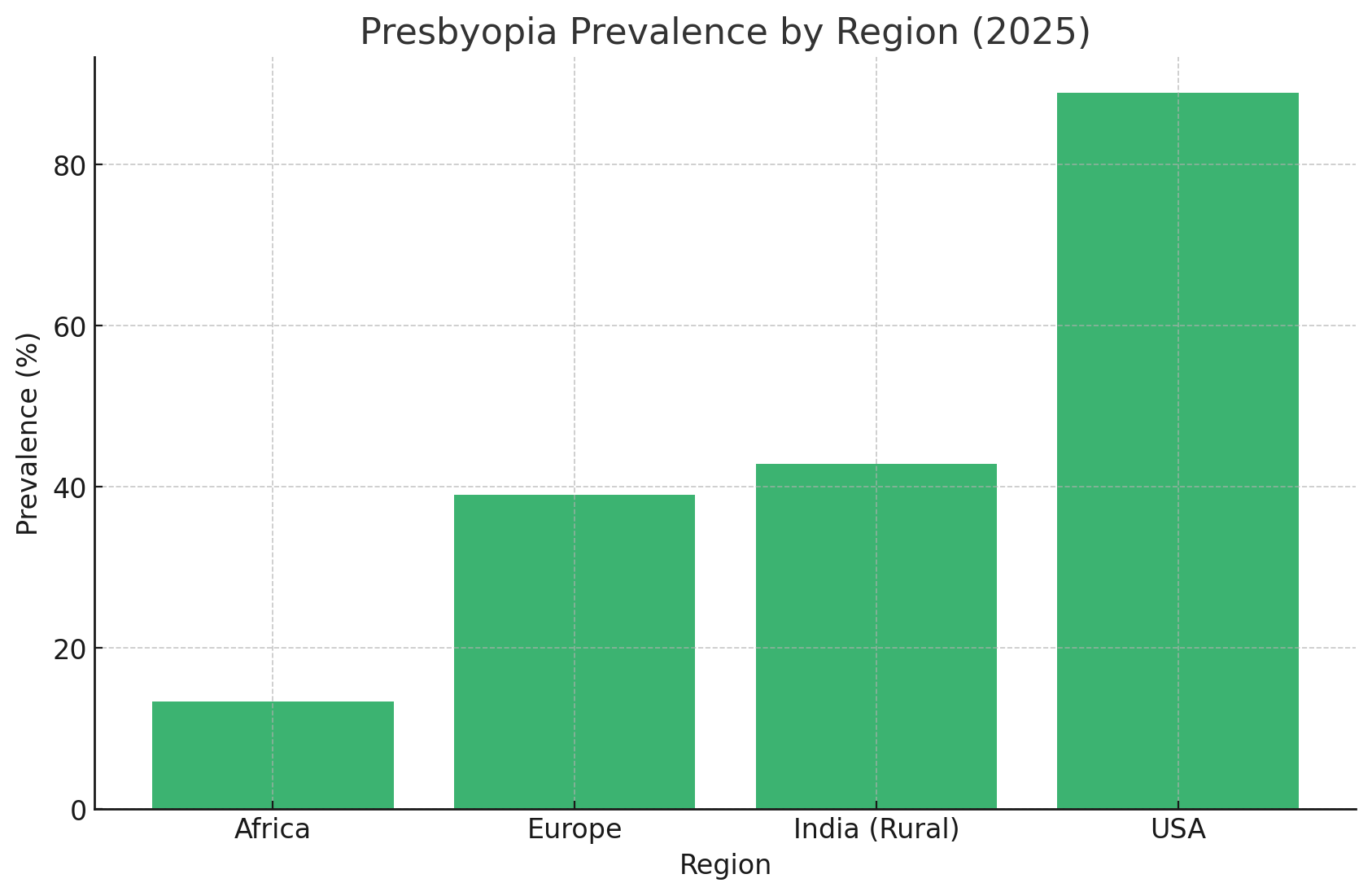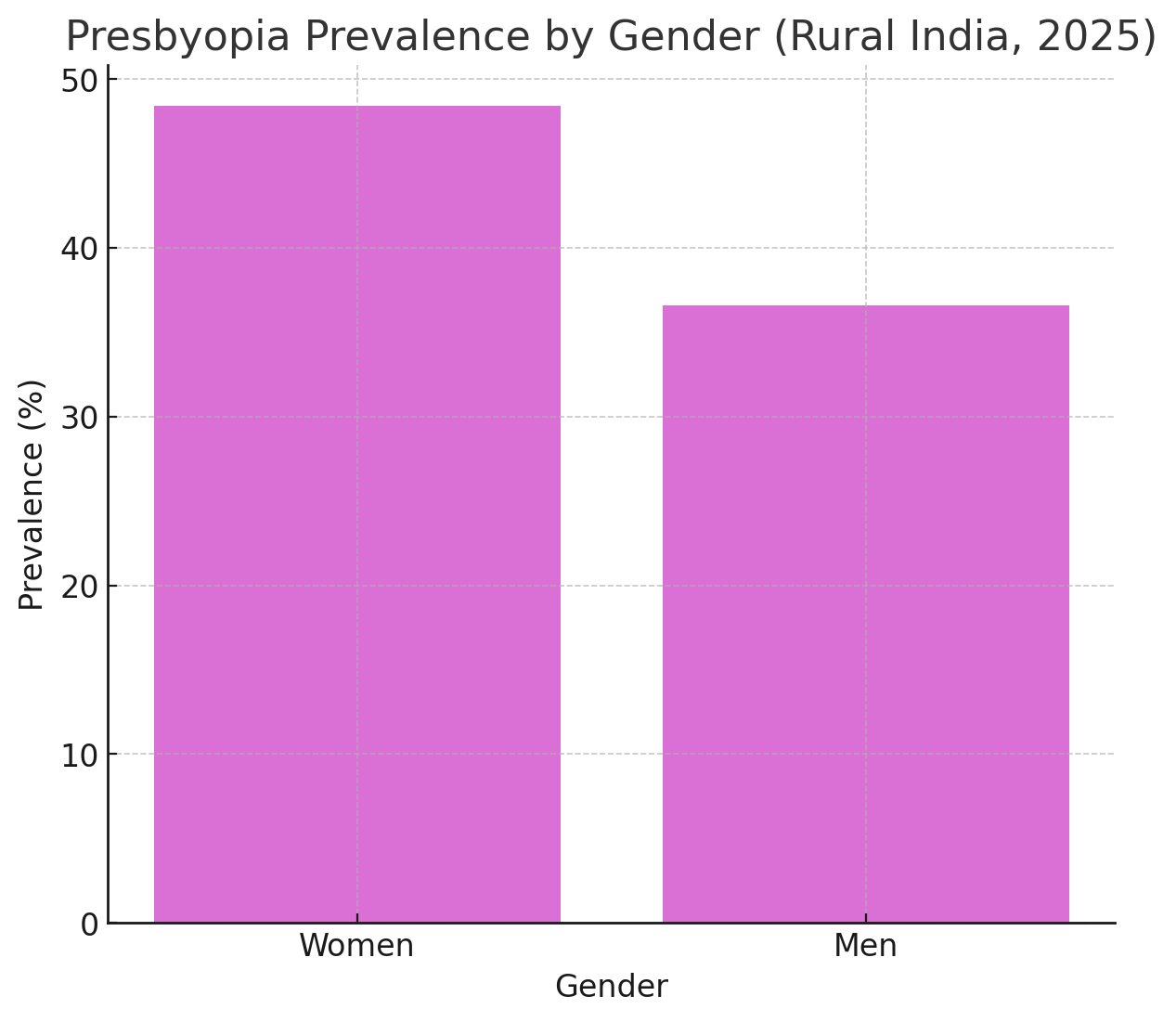In 2025 around 1.8 Billion people worldwide are presbyopic!
Presbyopia is an age related refractive condition that is characterised by the gradual loss of the eye's ability to focus on nearby objects and it continues to be a really significant global public health concern in 2025. As we age and life expectancies increase, presbyopia cases rise too, impacting our quality of life and posing a real challenge to healthcare systems worldwide. Let’s take a look at the current statistics, regional variations and implications it has on the economy.
Global Prevalence of Presbyopia
As of 2025, presbyopia affects a very large portion of the world’s population. Estimates suggest that around 1.8 Billion people worldwide are presbyopic. That is about 25% of the global population! And this number is only expected to go up in future because of demographic shifts, particularly the growing proportion of older adults. By 2030, the number of individuals with presbyopia is expected to reach a whopping 2.1 Billion!
Regional Variations in Prevalence

Presbyopia really varies quite a lot across different regions because of factors such as age, access to eye care services and economic conditions:
• Africa: Central Africa reports some of the lowest rates with only 13.4% of the population affected.
• Europe: Western Europe has much higher rates of up to 39.0%.
• Asia: In rural districts of India studies have found presbyopia rates to be 42.9% among adults aged 35 and older.
• North America: The USA reports shockingly high rates, with estimates ranging from 83.0% to 88.9% in adults aged 45 and older.
Uncorrected Presbyopia and Impact
A massive worry is the high number of uncorrected presbyopia. Globally, there are an estimated 826 million people who suffer from near vision impairment because of a lack of vision correction. The burden of uncorrected presbyopia is much higher in low and middle income countries, where unfortunately access to affordable eye care services is limited. For example, near vision correction rates are as low as 6% in Africa versus 96% in Europe.
Demographic Factors Influencing Presbyopia

Quite a few demographic factors influence the rates and severity of presbyopia:
• Age: The probability of developing presbyopia increases with age. Studies indicate that adults aged 50–59 years have nearly 12 times higher odds of having presbyopia compared to those aged 35–39 years.
• Gender: Women are more likely to develop presbyopia than men. In a rural Indian study, 48.4% of women aged 35 and above were presbyopic, compared to 36.6% of men.
• Education and Occupation: Higher levels of education are associated with increased rates which is most likely because of greater awareness and reporting. On the other end, individuals who are engaged in labour intensive occupations may have lower reported rates.
Economic Implications
Uncorrected presbyopia has real economic repercussions. The World Health Organization estimates that vision impairment which includes that caused by uncorrected presbyopia, results in global productivity loss of approximately US$ 411 billion a year.
Treatment and Market Trends
The treatment for presbyopia includes:
• Prescription Lenses: Reading glasses and bifocals remain the most common and cost-effective solutions.
• Contact Lenses: Multifocal and monovision contact lenses are a great treatment option for those who want a glasses-free treatment.
• Surgical Interventions: LASIK, corneal inlays and intraocular lens implants are available however the problem is that they are not really an affordable option for most.
The global market for presbyopia treatments is experiencing growth and in 2025 it is valued at $10.70 billion, with projections to increase to $13.30 billion by 2029. This growth is driven by technological advancements, increased awareness and the rising cases of presbyopia.
Conclusion
Presbyopia remains a global health issue in 2025, affecting billions of people and with economic and quality of life effects too. Addressing this challenge requires a real global effort to improve awareness, accessibility and mainly the affordability of eye care services worldwide.
Sources:
https://www.contactlensjournal.com/article/S1367-0...
https://journals.lww.com/jfmpc/fulltext/2022/01000...
https://www.presbyopiaphysician.com/issues/2022/ju...
https://www.who.int/news-room/fact-sheets/detail/b...
https://www.thebusinessresearchcompany.com/report/...
https://www.thebusinessresearchcompany.com/market-...
https://www.optometrytimes.com/view/cru-2025-presb...
https://www.globenewswire.com/news-release/2025/01...
https://contactlensupdate.com/2024/10/03/presbyopi...
https://www.ncbi.nlm.nih.gov/books/NBK560568/
https://www.thelancet.com/journals/langlo/article/...
https://www.aao.org/editors-choice/study-reveals-s...
https://www.aaojournal.org/article/S0161-6420%2817...
https://www.sciencedirect.com/science/article/pii/...
https://www.sciencedirect.com/science/article/pii/...
https://pubmed.ncbi.nlm.nih.gov/29753495/
https://bjo.bmj.com/content/early/2025/04/21/bjo-2...
https://www.coherentmarketinsights.com/market-insi...
https://www.imarcgroup.com/presbyopia-market
Author: John Dreyer Optometrist Bsc(Hons), MCOPTOM, DipCLP
Created: 24 Apr 2025, Last modified: 24 Apr 2025

